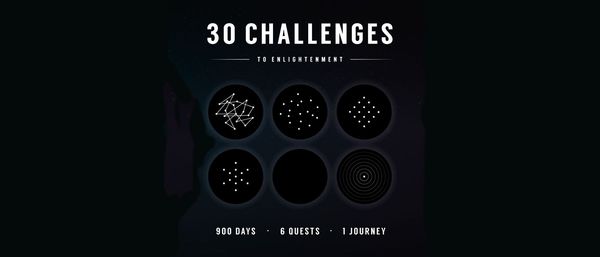Adam Di Stefano • • 17 min read
The Perfect Productivity System That Won’t Work For You At All

I’m a productive person.
I’m organized, and I don’t struggle to get stuff done. People often ask me, “do you ever sleep?”
In fact, I sleep a solid 7.5 hours a night. There’re enough hours in the day if you know how to use them.
But I wasn’t always this way. Upon entering law school, and then even more upon exiting law school, I struggled with stress and anxiety that stemmed from having too much to do, with not nearly enough time to do it in.
I searched high and low for ways to do things more efficiently, and eventually started spending hours and hours obsessively reading up on “life hacks” and “productivity systems“.
For the last decade, I’ve been designing, developing and tweaking my very own personal productivity system. It’s helped me get more done than ever before, and more importantly, without the once crippling stress and anxiety.
In this article, I’m going to share every single last detail of my system. Hours of research and frustration reduced down to the essentials.
But you know what?
It won’t help you.
Neither will any single productivity system you can read about. Well, maybe I’m being a bit too hard on productivity systems here. But you’ll see why in a moment. My exact productivity system probably won’t work that well for you, but the principles on which it was founded will help you build your own.
Let’s have a look at how productivity systems are meant to work before we dive into the nitty gritty.
Productivity Systems
There are a number of productivity systems out there that promise to make you more efficient, happier, richer, and better looking. The bibles of these systems are The 7 Habits of Highly Effective People


, The Pomodoro Technique (discussed here), and while not technically a productivity system, I’m going to throw The 4-Hour Workweek

into this list as well, because it was my introduction to the world of productivity.
There have been hundreds of books written on this topic, if not thousands, but those are the most well-known and the best. They are better written than most. They’re structured. They’re logical. And the techniques contained within them have worked for a lot of people.
However, if being productive were as simple as reading a single book, you wouldn’t have an entire industry pumping out book after book, year after year.
For a problem to be perennial, it must remain unsolved.
The problem with productivity systems is that they usually work for a while, (placebo, excitement, focus), and then don’t.
Productivity is like any shiny new object, after a while, the impermeance of positivity eats at its gloss.
The Details of a Productivity System
The other reason that productivity systems contained in these types of books fail is because they’re too detailed and complex. I don’t blame any of the authors; the productivity system I’m sharing with you now is pretty complicated.
When you coach someone at something, you tailor your coaching to the individual. You start by explaining the broad concepts, demonstrating, then adapting your approach based on the feedback you recieve.
However, without this biofeedback, you need to cover every possibility because you’re teaching every kind of student. Books aren’t custom made.
Try this experiment. Pick a single friend/co-worker/family member/whoever, and explain to them how to do a simple task. It could be frying an egg, shooting a basket, changing a diaper, whatever. The job doesn’t matter. For most people, this will be relatively straightforward, and you should be able to explain how to do this in a few minutes.
Now, take that same task and write it down. But, not just so that your friend can do it, but so that ANYONE can do it, including people who had never used a stove before, touched a basketball or held a baby. Go ahead, try it out, just for fun.
(I know you’re not going to try it out, but those who were thinking of trying it out, are the ones who will probably get the most out of this productivity system. Either way, you get the point.)
Writing something for the masses forces you to answer all the questions that could be asked by anyone. So even if one reader is more advanced than another, you’re always writing for the lowest common denominator.
You’re sacrificing the daisies for the shrubs.
This same thing that happens in productivity books. For example, here’s my summary of David Allen’s Getting Things Done methodology:
- Anything that takes less than two minutes to do should get done right away.
- Capture everything else that needs to be done outside of your head – like on a piece of paper.
- On a daily basis, take everything you captured and put it into a to-do list with priorities and context (when and where).
- On a weekly basis review what you accomplished, and what you need to achieve.
- Adjust your approach based on what you learn in your weekly review.
That’s it.
That’s pretty much the entire productivity method, and yet David Allen wrote a nearly-300-page book and had a thriving coaching business. His book is half explanation, half FAQ.
Because these productivity methods are over-written, they get into details that make the system less flexible to the needs of the individual. The result is a productivity system that either works for the average person (whatever that means) or for the author of the system: none of whom are you or I.
The only way around this is to scavenge the littered wasteland of existing productivity systems and salvage what works for you.
The bulk of my productivity system is a combination of Getting Things Done and the Pomodoro technique, but there are many more add-ons included from other systems.
This is the founder of High Existence’s productivity system. If you don’t have one to work with at the moment, use this: The 7P Productivity System
Popular Productivity Tools
Once you figure out a system that you like, the next step is to figure out what tools you can use to facilitate it.
Tools are the real place where you can spiral down the rabbit hole of productivity porn.
Over the years, I’ve used the following tools as part of my productivity system:
Analog:
- pen and paper
- post-its
- index cards
- whiteboards
- cork boards
- egg timer

Digital:
* excel files
- the action method
- google docs
- wunderlist
- any.do
- asana
- azendoo
- workflowy
- google calendar and tasks
- mailbox
- the pomodoro app (discontinued?)
- feedly
- trello
- scrivener
- ms outlook
- notational velocity
There is probably a ton of other tools that I’ve tried and discarded over the years; those listed are some of my favorites. I’ve been using Evernote since it launched, and others I use less frequently (I really wanted to use Asana and Azendoo more, but they are too powerful for my needs).
I used to believe that if only I could find the right set of tools, I’d be infinitely more productive. Of course, this is absurd. Da Vinci didn’t have Photoshop and a drawing tablet. Hemingway didn’t have Scrivener. Winston Churchill didn’t have MS Outlook.
Giving a man a hammer and a saw does not make him a carpenter. Similarly, giving him a smartphone and a laptop does not make him productive.
My 12-Step System (It Won’t Work for You)
So, to prove a point, I’m going to lay out, in excruciating detail, my productivity system that I use to be a reasonably successful, moderately productive, generally happy person.
At least once a year, I take a step back to see if what I’m doing on a daily basis is aligned with my highest aspirations. I did this exercise for the first time after graduating university, having no idea what I wanted to do with my life. Since then, it’s been a vital part of how I stay focused and productive.
This big-picture analysis really helps me observe the forest through the trees; my life through the daily grind.
Often, I’ll write this down in a journal entry, but sometimes, I’ll just reflect on it.
Once, after reading an interview with 50 Cent in GQ, I even created a vision board on Pinterest. I know that sounds like the weirdest sentence ever, but anything that helps you see the trends and flow of your life with an objective clarity really helps.
1. Create Yearly Goals
Every year, around Christmas, I take a few hours to set my goals for the year. This is sort of like a New Year’s resolution, but with the difference being that I set multiple goals, and I treat them as if they were professional objectives – that is to say I make them SMART (Specific, Measurable, Actionable, Realistic and Timely). The idea behind these annual goals is that they should align with my broader value system. If I’ve got goals that aren’t going to make me happier, or that don’t bring me closer to my core values, I know something’s up.
To give you an idea of how different annual goals are from New Year’s resolutions, most people set one New Year’s Resolution and then abandon it before the end of January. For the last three years, I’ve set between 6 and 10 goals per year, and accomplished over 90% of them. It’s not because I’m superhuman, it’s because of this next step.
2. Quarterly Goal Breakdown
Once I have my goals for the year, I break them down into quarterly milestones. These quarterly milestones do two things. First, they allow me to break my larger goals into more manageable pieces so that they don’t overwhelm me. Second, milestones are my quarterly checkpoints to see if I’m on track with my annual goals; to see if I’m living by my core values.
3. Break Milestones into the Tasks Necessary to Accomplish Each
Next is where the rubber starts to hit the road. For each milestone, I break down that milestone into tasks that I need to do to hit that milestone. A task is something that has to be concrete enough that I know exactly what needs to be done, with a clear estimation of how long it will take.
For instance, a goal can be, “Write book on cheese.” A milestone would be, “First draft complete.“ A task would be, “Write 1,000 words.”
4. Divide Those Tasks Into Months
Now that I’ve got a list of tasks for the quarter, I divvy those tasks up into the three months.
5. Schedule Tasks at the Beginning of Each Month
With your list of tasks for the month defined, take a few minutes at the beginning of each month to schedule those tasks. Some may be daily tasks, some may be weekly, some may be one-time tasks. Either way, every task you have to do that for that month should have a due date.
6. Review Successes and Failures at the Beginning of Each Month
At the same time as you’re setting your tasks for the upcoming month, take a moment to review your tasks for the previous month. Evaluate what you accomplished, take a moment to congratulate yourself, and push anything that you didn’t accomplish into the next month.
7. Create a Weekly Schedule For Recurring Rituals
Your basic schedule for the week involves all of the recurring tasks that need to get accomplished during that week. In my world, my weekly schedule involves house chores, writing, exercise, financial check-ins, a weekly review and daily rituals.
At the beginning of each week, I will look at what I have planned for that week with recurring tasks as well as tasks that are tied to my goals and see if it makes sense. At this point, I may move some things are if certain days look particularly heavy, or if there are other life events that conflict (like having a social life, for instance, which you’ll notice I do not schedule)
8. Send New Tasks to Inbox
On a daily basis, new things you need to do will come to your attention. Just like in the GTD methodology, I believe it’s important to record these outside of my head. These tasks go to inboxes, a spot that’s easy to capture so that you don’t need to stop whatever you’re doing to see when you can fit that in. The important thing is to know what your inboxes are so that you know where to look when scheduling new tasks. In my case, I have both physical and electronic inboxes to capture tasks depending on where they’re coming from.
9. At the End of Every Day, Clear All Inboxes and Create Tasks with Due Dates
This is where you take all those tasks in your inbox(es) and add them to your task list with a due date. This can be done at the beginning or the end of the day, but I prefer to do it at the end of the day so that I can go to sleep knowing that nothing is pending.
If you’ve already scheduled all your tasks, then the process of setting your task list should be relatively straightforward because you’ll know what needs to get done the next day.
And now for the most important parts of this system…
10. Prioritize Your Tasks in Accordance with Your Long-Term Goals
This is a step that a lot of fans of lists skip. The idea is that if you can get everything done, what difference does it make if you put everything in order?
This is important for two reasons:
- I don’t think anyone gets everything done, always. Life just doesn’t work that way, so this way you make sure you get the most important stuff done first.
- Once your most important tasks are done, the rest of your day is easy, because you can at the very least feel that you’ve accomplished something, and you don’t need to really stress out about the rest of your to-do list.
11. Use The Pomodoro Technique (25 Minute Intervals)
This is another blatant theft from an existing productivity system: the Pomodoro Technique. I’ve experimented with different lengths of work sprints, but twenty-five minutes seems to be the sweet spot for me. It’s long enough that I can accomplish a fair amount, but not so long that my ADD kicks in, and I lose focus altogether. The other side-effect of working in 25 minute sprints with a timer is that the moment that timer begins, you can no longer procrastinate. So, for a chronic procrastinator like myself, the only action I need to force myself to take is to turn on that timer, and the rest flows.
This is an awesome illustrated guide to the Pomodoro Technique.
12. Whatever You Can’t Finish, Push it to Next Day
And that’s it. Just repeat this system daily until you accomplish your goals. If you keep getting new goals, then keep doing the system. Oh and make sure to celebrate your wins, enjoy the process, and skive now and then.
The Tools I Use Today (It’s Not About the Tools)
Inboxes:
- architect’s wallet
- notebook
- mailbox / outlook
Task list:
Delegated tasks:
Storage:
Global goal tracking:
- MS excel
The Principles (These Will Work for Everyone):
So, the above is all the stuff that I do that’s specific to me that if you try to adopt at wholesale, might help you in the short term, but not the long. It’s meant for me. It’s my system. Writing down my productivity system was the first time I realized how heavy it was, and yet, I don’t even think about it. It comes naturally to me because that’s what works for me.
Everyone wants the perfect diet, the perfect workout routine, the perfect productivity system. You can get it, but you can’t buy it. You have to make it yourself. Here are the overarching principles of all good productivity systems. These will serve as the building blocks for your productivity system that won’t help anyone else at all.
1. Clear Your Mind
The reason I became a productivity junkie wasn’t because I wanted to accomplish more. Rather, it was that when I had a lot to do, I got stressed. When things were floating around in my head, I felt like I would just jump from one to the other, feeling overwhelmed and, as a result, I was never able to properly cope with anything.
David Allen’s imperative to get everything out of your head, came to me as a revelation. It allowed me to stop living in my head. Once things are outside your head, it can still look daunting (especially when your to-do list starts to look more like an airline flight manual), but at least it’s finite, and it’s concrete. In your head, you go around in circles.
It doesn’t matter if you do this on a pad of paper, in one of a dozen applications, or if you write it on your hand. The important thing here is to clear your mind.
2. Focus On One Thing
Once your mind is clear and you have a good understanding of what you need to do, the next important principle to keep in mind is that you can only do one thing at a time. Multi-tasking has been thouroughly debunked, and now pretty much everyone is a proponent of “monotasking” or “unitasking” or whatever we’re calling it this week. In order to move forward, you need to focus on a single thing for a particular period.
The Pomodoro Technique suggests using 25 minute increments, followed by 5 minute breaks, and then swapping in a 15 minute break after four rounds of that. Personally, that’s too intense for me. However, I do use a 25 minute timer for every single task I need to focus on. When I write, I do it in 25 minute sprints. When I’m creating a presentation, I do it in 25 minute sprints. When I’m brainstorming, I do it in 25 minute sprints. I even sometimes do chores in 25 minute sprints. However, I’ve never completed 4 sprints of 25 minutes consecutively. I’ve never needed to.
The period of time doesn’t matter; you just need to focus on one thing. That is the only way you will make progress on your list.
3. Ritualize Stuff
I used to be the worst procrastinator the world has ever seen. In school, I wouldn’t just wait until the night before to start cramming, I would actually start the morning of. I was incapable of achieving anything without a hard deadline. There’s only one thing that I’ve found that has been able to break me of my procrastination, and that is the creation of habits.
The old procrastinating me would never be able to write a minimum of 1,000 words per day. However, older, wiser Adam has learned that if he sits down to write first thing in the morning, with a cup of coffee, before checking email, and before even having breakfast, he will always accomplish something.
But you don’t need to be a morning person. A lot of people will try to tell you when the best time to do things is. It doesn’t matter. What matters is that you’ve created habits that allow you to move things along. I’ve also created other habits: daily meditation, a weekly planning session to set my agenda for the week, as well as a monthly review to make sure I’m on track with my broader goals.
It doesn’t matter what your schedule is, where you do it, what tools you use to do it, as long as you create habits that work for you.
4. Prepare For Success
A key to productivity is being ready to get down to it as soon as the time comes. I’m a big believer in advanced preparation. Every morning (or as often as I can), I start my day with my to-do list already on my desk. My desk is set-up to be the most comfortable working space possible.
When I run, I make sure that the day before I’ve set my running gear up right by the door, so that I don’t waste any time searching for the right socks or whatever.
What your rituals are, and how you prepare them, is going to vary depending on what you need to get done, but the point is to make sure that you’ve set your physical and mental space up for success. I once talked to an aspiring artist who was having a hard time committing the time necessary to do what needed to get done for his art. When I asked him where he did his work, his answer was, “Oh you know, here and there. I set up wherever I can.”
No, I don’t know! It seems to me that if every time I needed to get to work painting I had to take the time to figure out where I was going to set up, then actually set my easel, paints, brushes and other equipment up, the task would be too daunting to ever begin!
5. Don’t Beat Yourself Up
I’ve always had a hard time applying this principle, but as I gain experience in life, I realize that no one is successful 100% of the time. When we hear about the greats, we only hear about the positives, but dig a little deeper, and you’ll find failures. Don’t believe me? Read any well-written biography of a great man or woman from Jobs to Churchill, and you’ll find that these mythical figures are far less perfect than we have made them out to be.
On a smaller scale, sticking to a productivity system, or not completing your to-do list for the day is very similar. It happens. It will happen. So prepare for it. Create contingency plans. Expect failure and know what to do when it occurs. As productive as I am, the number of times I’ve curled up on the couch and done a Netflix marathon is embarrassing to admit (even more embarrassing would be what I’m marathoning, but I digress).
Bottom line: Failure happens. Expect it. Learn from it. Bounce back better for it.
6. Think Big Picture
The biggest trap of any productive person is getting things done for the sake of getting things done. Crossing something off of a to-do list might be gratifying, but if you’re not tying that back to a broader goal, or better yet, a value that’s important to you, then you will eventually hit a wall and wonder why you’re doing it all.
In moments like these, take a step back and ask, “why am I doing this again?” Oh yeah, because X is important to me, and this will help me accomplish Y, which will further X.
Remembering the bigger picture is also a great way to remember not to beat yourself up over failure. When you get out of your own head and recall that you’re a small piece of a much larger world, suddenly your to-do list seems much less significant. The goal of this isn’t to depress you, but rather to relieve some pressure from you. If you don’t sweep the floors today, will the world stop turning? Will someone die? Don’t lose perspective.
The Goal of Productivity
Doing stuff for the sake of doing stuff is worse than useless, it’s counter-productive. Productivity is not about getting more important stuff done because you know what, if it’s that important, it’s going to get done one way or another. It might be painful, and it might not be as good as it could be, but anything that’s truly important will get done one way or another.
The goal of productivity is to be happier and be less stressed.
Did you ever think that maybe, every single time you were looking for ways to be more productive, more efficient, etc., all you were really looking for were ways to improve the quality of your life? You, just like me, have been looking for ways to increase your happiness, and decrease the negative emotions in your life, like stress.
Keep that ultimate goal in mind as you bounce through this journey of finding ways to be more productive, and suddenly, all of these different systems and tools become a lot easier to asses.
“Is using this new productivity app going to make me productive?” is a difficult question to answer.
“Is using this new productivity app going to contribute to my happiness?” is a far easier question to answer.
So, there you have it, my entire system that works pretty well for me, but probably won’t work at all for you.
But maybe, just maybe, there was something buried in there that can help you live a happier, less stressful life. If there was, then I’d say the last few minutes of your day reading this have been a pretty productive use of your time.










